IPTV
Internet Protocol Television 2017

If we set aside accurate technical description of IPTV, the easiest answer for general public should like this:
"Television delivered by the Web." The IP in IPTV is just a delivery mechanism. We can add a little bit more to the description. That is, "IPTV is a consumer product delivered on demand with more immersive and interactive experience while the stream from the device is controlled by the user." When it was first launched, it mostly meant to be a "telco TV for telco customers", but it's now changed to mean something else. It's moving toward to hybrid multi-platform network, of course, using Internet Protocol.
Now, we'll try to define it again using more technical terms.
The term IPTV (Internet Protocol Television) refers to television distribution services in networks (closed, secure, managed, and private) controlled by a company which ensures the Qos (quality of service).
There is a confusing term used to describe another type of TV services. It is called ITV (Internet Television). We should not confuse IPTV with ITV, which refers to services offered via the Internet that have no control on the transmission by the provider (open, public, global Internet). They are best effort services based on the UDP protocol while IPTV is based on TCP. Both Internet TV and IPTV offer interactivity, but IPTV brings these capabilities to the TV screen. This includes features such as caller ID and SMS (short messaging service) along with more targeted advertising.
So, we cannot say that IPTV is using Internet (Web). It's a closed system owned by telcos. The purpose of the system is to deliver licensed contents that telcos got from the content providers. Subscribers can enjoy the contents with quality and stability by paying the fee for those contents. ITV, on the other hand, using open internet (OTT, over the top) but not the managed and closed network system. One example of ITV is the broadcast from MLB. Viewers are paying for the game and watch the game via internet.
In Telcos' perspective, the traffic caused by ITV is hurting their business. But they cannot complain it because of internet's core philosophy, Network Neutrality.
Let's redefine IPTV.
IPTV (Internet Protocol television) is the delivery of video stream encoded as a series of IP packets over a packet-switched network such as the Internet, instead of being delivered through traditional terrestrial, satellite signal, and cable television formats. IPTV is distributed by a service provider and can deliver either live TV or VoD. It can be bundled with other IP services, such as VoIP and high-speed Internet access.
In traditional television delivery, all programming is broadcast simultaneously. The available program signals flow downstream and the viewer selects which program he wants to watch by changing the channel.
IPTV, on the other hand, sends only one program at a time. Content remains on the service provider's network and only the program a viewer selects is sent to the home. When a viewer changes the channel, a new stream is transmitted from the provider's server directly to the viewer.
I found 3 diagrams of IPTV from the Web. One is the simplest and the other two are more descriptive.
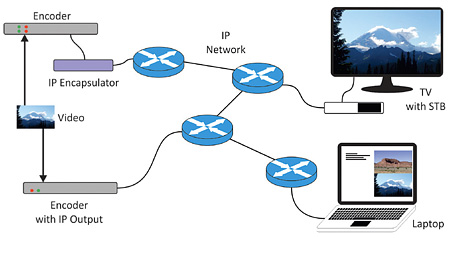
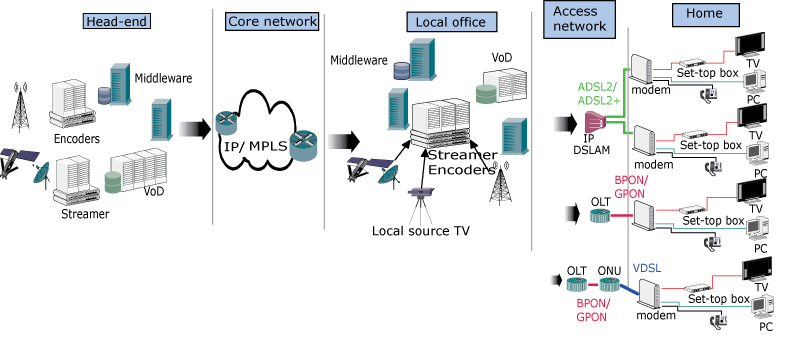
Source http://pandatron.cz/
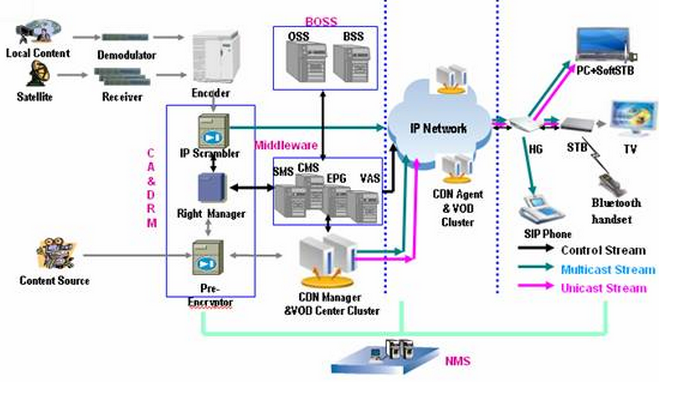
Source http://www.gcpcom.com
The basic nature of most of network technologies is that they are more concerned with pumping data as fast as possible than they are with how the data is sent. For instance, the Internet is designed on top of the Internet Protocol (IP), a packet-switching technology that is designed to get packet from point A to point B in the most effective way, without requiring the user to have any knowledge about what router will be taken. Actually, some packets may be stored for a while before being forwarded to their destination, or even dropped and retransmitted.
For simple file transfer, this is fine. However, there are applications for which this sort of service represents low quality. In these cases, the nature of how the data is delivered is more important than merely how fast it is, and there is a need for technologies or protocols that offer QoS such as following:
- Bandwidth (resource) Reservation
The ability to reserve a portion of bandwidth in a network or interface for a period of time so that two devices can count on having that bandwidth for a particular operation. This is used for multimedia applications for which data must be streamed in real time, and packet rerouting and retransmission would result in problems. - Latency Management
A feature that limits the latency between two devices in any data transfer to a known value. - Traffic Prioritization
In conventional networks, all packets are created equal. A useful QoS feature is the ability to handle packets so that more important connections receive priority over less important ones. - Traffic Shaping
This refers to the use of buffers and limits, both of which restrict traffic across a connection to a value below a predetermined maximum. - Network Congestion Avoidance
This QoS feature refers to monitoring particular connections in a network and rerouting data when a particular part of the network is becoming congested. - Asynchronous Transfer Mode (ATM)
This is one of the QoS feature hat has received a lot of attention. ATM is designed to support traffic-management features that are not generally available on networks that haven't been optimized to provide QoS feature such as Ethernet.
- Head-end
Where TV channels are encoded, encrypted (Digital rights management (DRM) or Conditional Access (CA)) and delivered in the form of IP multicast streams. Also, Operations Support System (OSS) and Business Support System (BSS) can be done at this level. - VOD platform
Where on-demand video assets are stored and served when a user makes a request in the form of IP unicast stream. - Interactive portal
This allows the user to navigate within the different IPTV services, such as the VOD catalog. - Delivery network
Packet switched network that carries IP packets (unicast and multicast). - Home gateway
Equipment at the user's home that terminates the access link from the delivery network. - Set-top box (STB)
Equipment at the user's home that decodes and decrypt TV and VOD content and displays it on the TV screen. In other words, set-top box, connected to the home DSL/Cable line, is responsible for reassembling the IP packets into a coherent video stream and then decoding the contents.
Here is more detailed description of each steps, a little bit outdated and focused on telco side, but I think it still holds up well.
- Managed(Closed) Networks has control over the following:
- bandwidth allocation
- contention ratio
- content
- Unmanaged(Open) Networks
- Variable bandwidth
- Higher contention ratio (20:1)
- Less control over content
Here is the list of Top 10 IPTV markets based on subscribers in the world as of Q4, 2014.
China still the world leader in terms of IPTV subscribers, followed by France. A new entrant from Asia has also joined the top ten list. Europe is the top performing region.
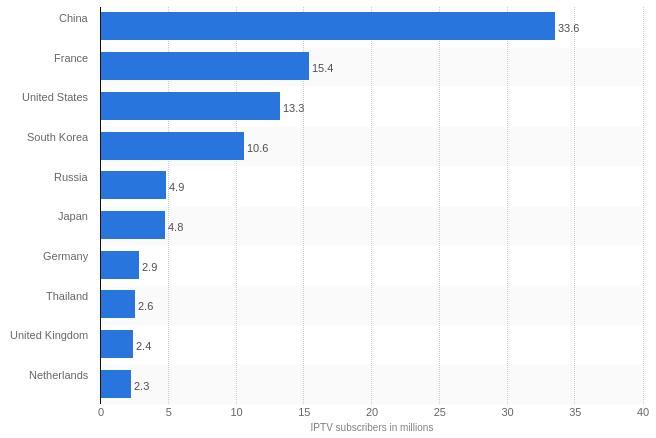
When we compare IPTV with Smart TV, they may be different in terms of hardware. However, if we we look at them from service side, they are doing the same thing: both of them provide full browser support, they can play back multimedia contents, and both utilize app store.
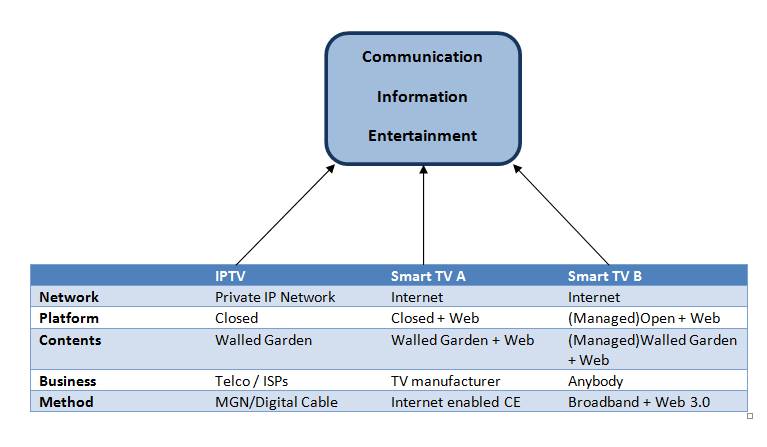
Technologically, we can say IPTV and Smart TV are now similar , but the BM, the way how they value the service, and ecosystems are different as we see in the table below.
Comparison of IPTV and Smart TV
| IPTV | Smart TV | |
|---|---|---|
| Market | Local | Global |
| Network for delivery | Premium network | General purpose internet |
| Securing User | Subscription | TV sale |
| Business Model | Monthly fee | Free |
| Type of Business Model | Cost-based | Value-based |
| Costs for contents per user | High | Low |
| Size of Ecosystem | Small | Big |
| Expansion Costs | High | Low |
| Value of Advertiser | Low | High |
Also, we need to look at N-screen (Connected Devices) .
Ph.D. / Golden Gate Ave, San Francisco / Seoul National Univ / Carnegie Mellon / UC Berkeley / DevOps / Deep Learning / Visualization